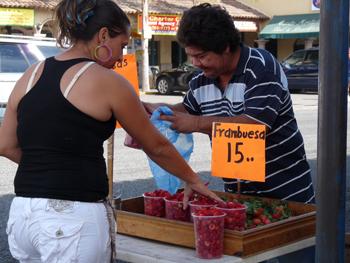
A local merchant sells containers of fresh organic raspberries for 15 pesos, or $1.10.
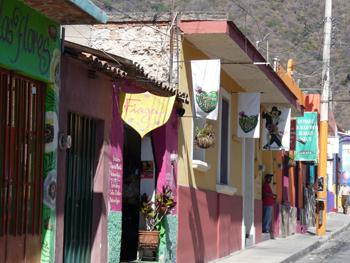
Colourful colonial buildings line the narrow cobblestone streets.
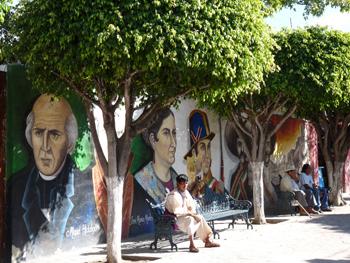
Ficus trees and murals adorn Ajijic's central plaza.
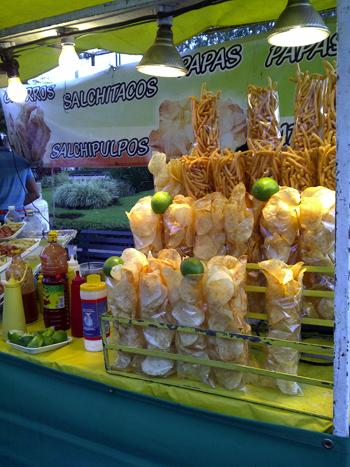
Fresh potato chips with lime and hot chili sauce.
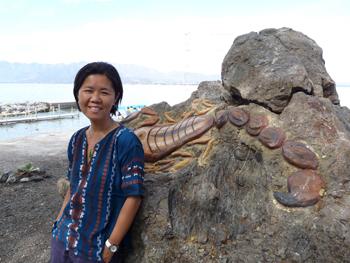
The author, rookie Toronto Councillor Kristyn Wong-Tam, on Scorpion Island, one of two islands in Lake Chapala.
After a hectic first year at Toronto City Hall, this rookie councillor decided to finally turn off her BlackBerry and take a December vacation.
I pack my suitcase and head south for Mexico, a land of rich indigenous cultures, iconic muralists and sublime beaches.
This time, instead of hanging with the usual beach bodies in Playa del Carmen or Puerto Vallarta, I travel to Ajijic, “the place where the water springs forth.” With a population of approximately 15,000, it’s only 30 minutes from the Guadalajara International Airport and 45 minutes from the bustling metropolis and convenience of you-can-get-anything-there Guadalajara. Ajijic is proving to be a popular destination for sun-seekers from around the world.
This village of true Mexican pueblo architecture, with colourful buildings, narrow cobblestone streets and a central plaza, rests on the shores of Lake Chapala, Mexico’s largest freshwater lake. In this 500-year-old village, the influences of the indigenous Nahuatl Indians and the Spanish conquistadors are still in evidence.
As Canadians approach midlife, many begin to consider where they would most like to retire once they break free of the workaday life. I chat with some of those who have already made the leap at the Lake Chapala Society, an English-speaking expatriate social support centre in Ajijic. “Why did you choose to come here?” I ask. In essence, I am asking what makes a community ideal. They are questions I ask at every single community-planning meeting as a Toronto city councillor. Invariably the replies include similar criteria: walking distance to amenities, affordable housing, green space, safety, reliable healthcare, proximity to transportation, access to social networks and availability of support systems. People in both Toronto and Ajijic want their home communities to be the most livable they can be.
This all sounds wonderful, but truly, how gay-friendly is Ajijic? It’s an important question for gay people. For most, retreating back into the closet even for near-perfect weather and a substantially lower cost of living is simply not an option. This concern is further compounded for gay and lesbian seniors in search of retirement homes and long-term care facilities. We need healthcare providers that will accept our sexualities, know how to care for us and respect our chosen families.
We have seen gay Mexican refugees flee to Canada and the US from homophobia in their home country. In Mexico, as in most other countries, gay and lesbian people with financial means can more easily avoid political and social punishment by blending into the general population. Gay and lesbian tourists and expatriates can find homes here, even where civil liberties are curtailed. Money has a way of buying independence and freedom. But many gay and lesbian people in Mexico, without money or support, simply have no choice and are forced to flee for their personal safety.
In Ajijic, at the designated Gay Night promoted on Wednesdays at the four-month-old bar, Salt and Pepper, I meet Nicholas Fabian, the easygoing bartender who commutes to work in Ajijic almost daily from Guadalajara. He reports that Wednesday nights are the busiest for this straight-owned business. It’s at Gay Night that the stylish bar and restaurant is filled with local gay and lesbian expatriates from the village and with Mexicans wanting a break from the frenetic club culture of Guadalajara.
As Céline Dion’s “My Heart Will Go On” plays in the background, Fabian says he enjoys working Wednesday nights. “Gay people are nicer and give better tips,” he says. “I am appreciated by them.” He seems qualified to make this observation as he has worked in the bustling bars of Guadalajara, where sometimes “people go out to just get drunk, and in Ajijic, the older couples keep to themselves.”
Curley Lieberman, 64, a retired schoolteacher and out lesbian from Seattle, agrees that gay couples keep to themselves, especially the older women. However, for a single gal such as herself, that’s not necessarily a good thing. Lieberman does lead a full life by coordinating Spanish classes and participating in theatre activities but admits, “It’s not easy meeting single women,” and finds it hard to adjust to the lack of a visible lesbian community.
I ask Lieberman why, in that case, she chose to retire in Ajijic. She replies without skipping a beat, “The weather is fabulous, affordability is a big factor, and so is the easygoing lifestyle.”
Tina Rimer is a youthful 48-year-old woman from Los Angeles who moved to Ajijic after her Mexican girlfriend was twice denied a visitor’s visa to the US. Rimer extols the openness in her adopted town: “Women hold hands in Mexico all the time and it’s not a problem. I’m not saying there’s no homophobia, but overall people are very accepting and open-minded.”
Rimer’s smile disappears only when she states, “The stereotypes about Mexico are just not true. It’s not dangerous here, and Mexicans are the most honest people. The media has amplified the crimes here and it’s just racist.”
It’s a poignant observation. Even in the so-called summer of the gun in 2005, when 52 of Toronto’s 80 murders were gun-related, no media outlet or foreign government issued travel advisories warning tourists to stay away from Canada. The same can’t be said for Mexico.
Former Vancouverite and assemblage artist Rhonda Simmons, 48, agrees that Mexico is unfairly stigmatized by the press. After living in Ajijic for three months, this new expatriate is confident that she’s found home. Ajijic has long been an artist colony, and Simmons is determined to complement the local scene by creating a women’s artist-in-residency program. “Although Ajijic is not perfect and there is a financial hierarchy in the gay community, it’s still a great place to be,” she says. She plans to apply for her residency papers in the coming weeks.
Remembering Lieberman’s claim, I ask Simmons, who is single, whether it’s difficult to meet other women here. “There is that,” she says. “But as an artist, Ajijic is such an inspirational place, the good outweighs the bad.”
Steve Cross and his Mexican-born boyfriend, Fernando Gomez, are both in their 40s. I affectionately describe them as the teenagers of Ajijic’s community of gay men. The two met in Puerto Vallarta’s renowned party scene and, while planning a move to Argentina, wound up relocating to Ajijic.
Cross and Gomez are the proud operators of Casa Flores, an exquisitely appointed bed and breakfast, where they live with their two adopted poodles. Their gifts of hospitality and wealth of knowledge about the village are appreciated by their many repeat clients. The old-world architectural details of their casa are prominently featured along with their bold collection of art and fine crafts, carefully selected during the couple’s world travels.
“Ajijic is not just gay-friendly, it’s outright gay-positive, and we’re proof of this,” Cross says. “We came from Puerto Vallarta, which celebrates and promotes gay life, and we still chose Ajijic. The weather is perfect all year round. Fernando and I feel completely safe and accepted here.
“To be honest, we opened up the bed and breakfast with a five-year plan, and as we head into our fourth year, it will be very hard to leave,” he says with a smile. “Life is just so good, and we can’t think of a better place to be.”
There is no better place to be on Christmas Eve in Ajijic than at the 30-person dinner held at Casa Flores. There I am introduced to Pedro Palmer, who once managed the popular restaurant Fred’s Not Here on King St W in Toronto. Palmer has lived in Ajijic for 11 years. “I have found Ajijic to be very accepting,” he says in his graceful baritone. “Being gay is simply a non-issue here.”
Also invited to dinner is Damyn Young, 49, a successful area real estate agent who hails originally from Toronto. He has a sunny disposition that perfectly matches the Mexican climate. Young was working as the managing director of the Juvenile Diabetes Society in Vancouver when he met his partner, John Martin, 54, an accomplished entrepreneur. The two met on a bicycle ride while Young was visiting his retired parents in Ajijic. By the end of the ride, he and Martin were a permanent item, and they have lived together ever since. That was eight years ago.
Through Young, I meet Bill Orovan, the 71-year-old editor and publisher of Echo Magazine, a queer publication distributed mostly in Arizona. He’s been living in Ajijic for seven months and is renovating his new home. Orovan says he considered Puerto Vallarta, San Miguel de Allende and even Panama but ultimately settled in Ajijic because it felt most accepting.
Jeannie Dewey, an expatriate from Charlemont, Massachusetts, who moved to Ajijic two years ago, is a natural organizer and a woman on the go. She even started a Facebook social group, Muchas Machos Ajijic, for local lesbians.
Dewey says she arrived in Ajijic sick and in need of affordable healthy foods and alternative treatments for myalgic encephalomyelitis, a condition that causes severe fatigue. To her Ajijic is magical – not a word she uses flippantly. She says she’s feeling healthier and better than she has in years.
Later in the week I am invited to the Young family compound in Upper Chula Vista, an established non-gated neighbourhood with mature trees on the mountainside of Upper Ajijic, a short distance from the carretera, or main road, that connects the many towns around Lake Chapala. From the elevated garden, I survey the natural beauty of the Sierra Madre Mountains across the still lake waters and am treated to a breathtaking pink-and-violet sunset. With a cold beverage in hand, I exhale deeply for the first time in months and start to appreciate why the Young family and thousands of others have chosen Ajijic.
Even if Ajijic is not actually magical, not a single person I spoke with – expatriate or local – had anything negative to say about the town. As I have discovered, there is much more to Ajijic then meets the queer eye. The seductive charms of its rich history and friendly demeanour will ensure this Canadian gal will be returning sometime soon.
I can’t wait.
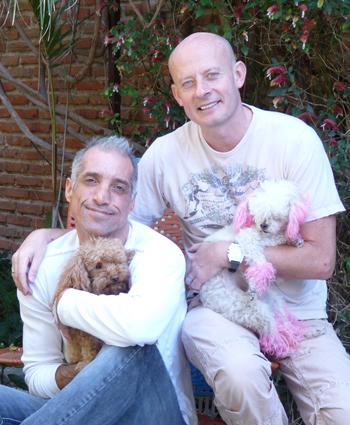

 Why you can trust Xtra
Why you can trust Xtra